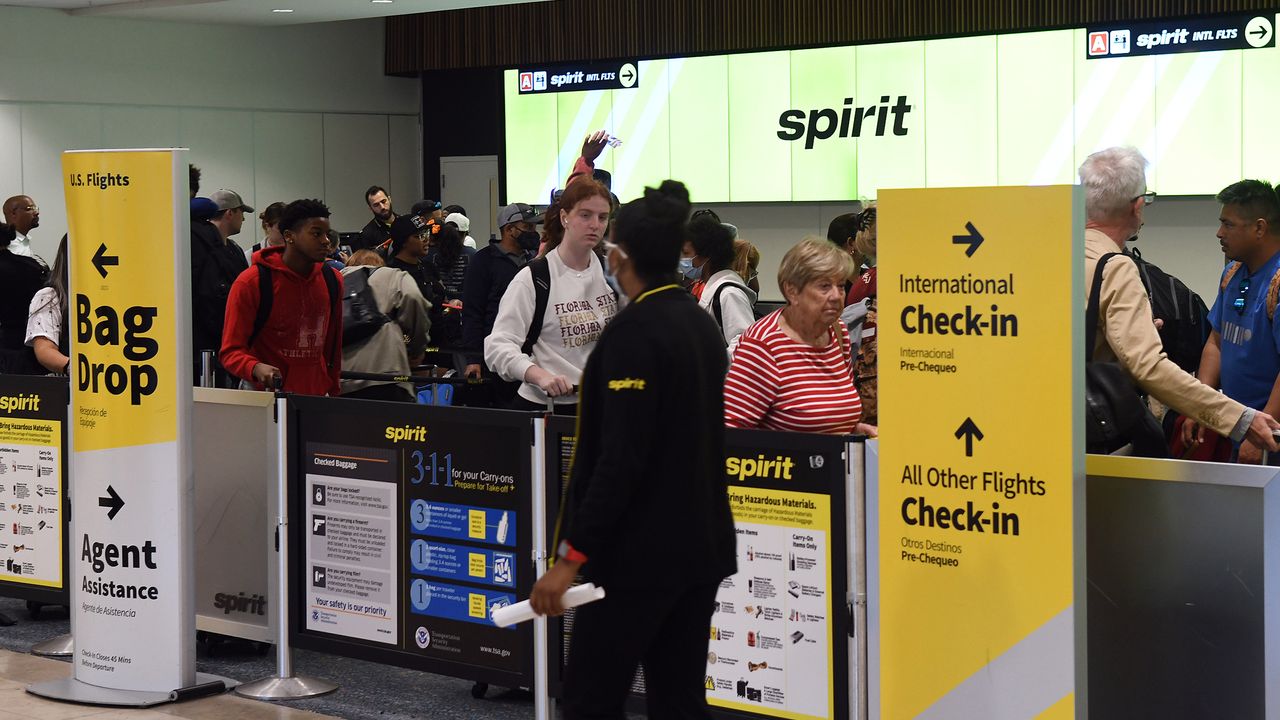Here’s What You Should Know About Spirit Airlines’ New Passenger Dress Code
Spirit Airlines announced a stricter dress code for passengers, including bans on bare feet and offensive tattoos.


Spirit Airlines recently announced a stricter dress code for its passengers. Following a couple of recent incidents in which Spirit staff barred passengers from boarding for wearing crop tops or hoodies with swear words, the airline chose to clarify its dress code and provide additional training to staff.
According to the updated contract of carriage, passengers may not be allowed to board if they are barefoot, “inadequately clothed” or have clothing or tattoos that are “lewd, obscene or offensive.” If a passenger is barred from the plane for violating the new dress code, the contract states that they aren’t entitled to a flight refund.
This dress code may be new for Spirit, but the rules are pretty standard for the industry. You’ll find similar restrictions in the fine print for other U.S. airlines. Even if you have no plans to fly with Spirit, it’s worth brushing up on the rules to make sure you don’t run into any issues at the gate.

Sign up for Kiplinger’s Free E-Newsletters
Profit and prosper with the best of expert advice on investing, taxes, retirement, personal finance and more - straight to your e-mail.
Profit and prosper with the best of expert advice - straight to your e-mail.
@nbcchicago ♬ original sound - NBC Chicago
Spirit’s new dress code is similar to existing rules on other airlines
The updated guidelines on Spirit are in line with the rules already in place on other airlines. Delta, United and American Airlines all refuse to board passengers who are barefoot, for example. All three also include some guidelines around passenger appearance.
In fact, Spirit’s new dress code is surprisingly clear compared to other major carriers. While Spirit includes detailed examples of what constitutes inadequate clothing, the rules for other airlines are decidedly vague.
American Airlines simply states that passengers must “dress appropriately” while United’s dress code bans passengers who are “not properly clothed.” Meanwhile, Delta’s dress code includes a broad ban on attire that “creates an unreasonable risk of offense or annoyance to other passengers.”
What fliers need to know to make sure they can board their next flight
Whether you’re flying with Spirit or another airline, it’s worth checking out the contract of carriage – sometimes called “conditions of carriage” – to see what the airline’s dress code is. This is especially important for those flying standby, travel rewards program members or those with airline status using a companion pass or enjoying a free upgrade. These non-revenue passengers – fliers using free or discounted tickets – are sometimes held to stricter dress code enforcement than other passengers.
If the dress code language is vague, err on the side of caution, because enforcement of the dress code falls on the staff. For travelers, this means that whether or not a travel outfit is deemed appropriate depends on the subjective interpretation of these often vague rules by the agent at the gate that day.
This has led to some controversial incidents, including a Delta passenger who was escorted off a plane last October for wearing a shirt that read “Do not give in to the war within. End veteran suicide.” Similarly, United came under fire for refusing to board two teens who were wearing leggings.
The bottom line
Your go-to, comfy travel outfit might not seem like a dress code violation to you. But all it takes is one staff member deciding the outfit is non-compliant to keep you from flying.
If you do get stopped at the gate, make sure you have a sweater or pair of sweatpants in a tote bag or your carry-on that you can throw on. Covering up will allow you to make your flight, and you can still file a complaint with the airline or with the Department of Transportation if you disagree with the decision.
Related content
Get Kiplinger Today newsletter — free
Profit and prosper with the best of Kiplinger's advice on investing, taxes, retirement, personal finance and much more. Delivered daily. Enter your email in the box and click Sign Me Up.

Rachael Green is a personal finance eCommerce writer specializing in insurance, travel, and credit cards. Before joining Kiplinger in 2025, she wrote blogs and whitepapers for financial advisors and reported on everything from the latest business news and investing trends to the best shopping deals. Her bylines have appeared in Benzinga, CBS News, Travel + Leisure, Bustle, and numerous other publications. A former digital nomad, Rachael lived in Lund, Vienna, and New York before settling down in Atlanta. She’s eager to share her tips for finding the best travel deals and navigating the logistics of managing money while living abroad. When she’s not researching the latest insurance trends or sharing the best credit card reward hacks, Rachael can be found traveling or working in her garden.
-
 Could Your State End Tax on Overtime This Year?
Could Your State End Tax on Overtime This Year?State Taxes Key states are considering ending taxes on overtime — find out if yours makes the cut.
By Kate Schubel Published
-
 Reduce Your Retirement Tax Risk With the Three-Bucket Strategy
Reduce Your Retirement Tax Risk With the Three-Bucket StrategySplitting retirement funds into three buckets with distinct tax treatments can help you avoid a nasty tax bill down the line. Here's how the strategy works.
By Bryan S. Slovon, Investment Adviser Published
-
 Trump's Tariffs Could Make Your Favorite Clothing Brands More Expensive
Trump's Tariffs Could Make Your Favorite Clothing Brands More ExpensivePresident Donald Trump announced tariffs on imported goods from a litany of countries. See how these tariffs will impact your favorite clothing line.
By Sean Jackson Published
-
 GameStop Is Closing More Stores — Here’s Where to Shop Instead
GameStop Is Closing More Stores — Here’s Where to Shop InsteadAs GameStop closes more locations, here’s how to score similar deals on games, consoles and collectibles at other major retailers.
By Kathryn Pomroy Published
-
 Retirees: Is Your Local Bank Closing? Four Ways to Cope
Retirees: Is Your Local Bank Closing? Four Ways to CopeBank branches are closing across the country. If you are among the retirees who prefer to bank in person, you have some options.
By Donna Fuscaldo Published
-
 Why I'd Put My Tax Refund in a Money Market Account
Why I'd Put My Tax Refund in a Money Market AccountA money market account offers you the benefits of having access to your money when you need it, while earning a rate outpacing inflation.
By Sean Jackson Published
-
 What Amex's Fine Hotels + Resorts (FHR) Program Gets You at Hotels In Sydney, Vegas and Lisbon
What Amex's Fine Hotels + Resorts (FHR) Program Gets You at Hotels In Sydney, Vegas and LisbonThree examples of hotel stays in Sydney, Vegas and Lisbon show what you get through American Express' Fine Hotels + Resorts (FHR) program.
By Sean Jackson Published
-
 How to Use Your Cell Phone on a Cruise
How to Use Your Cell Phone on a CruiseAvoid surprise charges and stay connected at sea with these expert tips on how to use a cell phone on a cruise.
By Paige Cerulli Published
-
 How Much You Could Save on Gas with Costco, Walmart and Other Memberships
How Much You Could Save on Gas with Costco, Walmart and Other MembershipsGas prices jumped 10 cents this week. Compare gas savings perks and see how much you’d save with Costco, Sam’s Club, BJ’s, Walmart Plus and Amazon Prime.
By Rachael Green Published
-
 How to Balance Your Insurance Expectations vs the Reality
How to Balance Your Insurance Expectations vs the RealityJust because you have an insurance policy doesn't mean that you're totally covered in the event something bad happens.
By Karl Susman, CPCU, LUTCF, CIC, CSFP, CFS, CPIA, AAI-M, PLCS Published